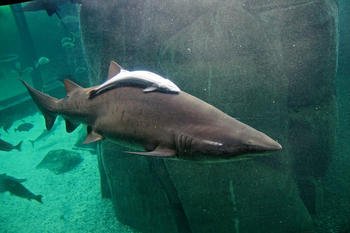Commensalism is the term used to designate a type of harmonic and interspecific ecological relationship , in which one species takes advantage of the food waste of another.
Commensalism is characterized by interactions between organisms of different species, without the species that benefits from harming the one that helps it. Therefore, it is beneficial for one species and absolutely neutral for another.
We call the commensal species that is benefited in the relationship, that is, that feeds. While the one who provides the food is called “host” or “host” .
The word commensal derives from the Latin ” commensāle “, which means “one who eats together with” or “guest at the table”.
Examples of Commensalism
As we have seen, commensalism involves the relationship in which an individual takes advantage of the remains of another, without harming him. Here are some examples:
Remora and Shark
This is the most classic example of commensalism. The remora is a small fish with suction cups on its dorsal region used to attach itself to sharks. Thus, the remora is transported and feeds on the food remains left by the shark. After feeding, the remora seeks another shark for a new association in search of more food. The shark does not suffer any damage from the relationship.

Man and Entamoeba coli
There is a commensal relationship between man and Entamoeba coli . The E. coli is a protozoan, the group of amoebas that live in the large intestine of humans and feeds on their digestive remains. It does not cause disease to man.
Lions and Hyenas
Hyenas are on the prowl for lions hunting. When the lions finish feeding, the hyenas take advantage of the remains of the game.
Man and Vulture
The vultures feed on the organic remains left by man. Large amounts of food are wasted by humans and end up in dumps, where the vultures feed.
Carnivorous Animals and Vultures
This relationship is very similar to that of lions and hyenas. After hunting and feeding the carnivorous animals, the birds take advantage of the remains and feed.
Commensalism and Tenancy
The term commensalism can also be attributed to a distinct connotation. The most common is to relate commensalism as an ecological relationship aimed at obtaining food by one of the species involved.
However, some authors consider the relationships between species that involve protection and shelter as types of commensalism. In this case, tenancy , a relationship in which one organism serves as a shelter for another, would be a form of commensalism.
Tenancy is also a harmonic interspecific relationship, in which one species benefits and the other suffers nothing, it is neutral.
In summary, commensalism refers to a type of relationship aimed at obtaining food. Meanwhile, the tenancy is aimed at protecting one of the species involved.
Commensalism and Mutualism
The mutual movement is a harmonic and inter relationship between individuals of various species. It has the character of food, protection or transport, in which both species benefit, unlike commensalism, where only one species is benefited.
